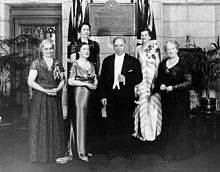Irene Parlby
Mary Irene Parlby (née Marryat; 9 January 1868 – 12 July 1965) was a Canadian women's farm leader, activist and politician.

Irene Parlby | |
|---|---|
_(16661079517).jpg) | |
| Member of the Legislative Assembly of Alberta | |
| In office 1921–1935 | |
| Preceded by | Andrew Gilmour |
| Succeeded by | Duncan MacMillan |
| Constituency | Lacombe |
| Personal details | |
| Born | Mary Irene Marryat 9 January 1868 London, England |
| Died | 12 July 1965 (aged 97) Red Deer, Alberta, Canada |
| Political party | United Farmers |
Born in London, England to Col. and Mrs. E.L. Marryat,.[1][2] Parlby came to Canada in 1896. In 1913, Parlby helped to found the first women's local of the United Farmers of Alberta. In 1921, she was elected to the Alberta Legislature for the riding of Lacombe, holding the riding for 14 years. Appointed as minister without portfolio, she was the first woman Cabinet minister in Alberta.
Parlby was one of the Famous Five or Valiant Five,[3] who by means of a court battle known as the Persons Case established that women were "qualified Persons" in the meaning of the Constitution of Canada and therefore entitled to sit in the Senate of Canada. Like others of the famous five, however, Parlby was an advocate for the eugenics movement in Alberta including the Sexual Sterilization Act and the sexual sterilization of the mentally infirm.
A lifelong advocate for rural Canadian women and children, Parlby was president of the United Farm Women of Alberta from 1916 to 1919. On behalf of the UFWA, she pushed to improve public health care services and establish municipal hospitals as well as mobile medical and dental clinics. In 1921, Parlby was elected to the provincial legislature and made a cabinet minister (the second woman in Canada to hold a provincial cabinet post).
She was once quoted saying: "...and what when we die? Should women go back to the state they once belonged to. No, they should rather take arms against it, and fight for acknowledgment, not uniformity." Here she fought for acceptance rather than equality to the male gender.
She was the last surviving member of the Famous Five.
Legacy
Among other honours, in October 2009, the Senate voted to name Parlby and the rest of the Five Canada's first "honorary senators."[4] Irene Parlby was recently awarded a mural in her honour in Edmonton, Alberta.[5]
The 1966, Irene Parlby was recognized as a Person of National Historic Significance by the government of Canada. A plaque commemorating this is found in Alix, Alberta.[6] The "Person's case" was recognized as a National Historic Event.[7]
References
- Cavanaugh, Catherine (4 March 2015). "Mary Irene Parlby". The Canadian Encyclopedia (online ed.). Historica Canada. ISBN 978-0-88830-326-4.
- Sanderson, Kay (1999). 200 Remarkable Alberta Women. Calgary: Famous Five Foundation. p. 43. Archived from the original on 24 September 2015. Retrieved 23 May 2013.
- Kome, Penney (1985). Women of Influence: Canadian Women and Politics (1st ed.). Toronto: Doubleday Canada. pp. 31–32. ISBN 978-0-385-23140-4.
- "Alberta's Famous Five named honorary senators". The Globe and Mail. The Canadian Press. 11 October 2009.
- Callsen, Laurie (3 July 2012). "Women's suffrage pioneers the Famous Five honoured in new downtown Edmonton mural". Metro Edmonton. Archived from the original on 14 June 2015. Retrieved 12 June 2015.
- Parlby, Mary Irene National Historic Person. Directory of Federal Heritage Designations. Parks Canada.
- Persons Case National Historic Event. Directory of Federal Heritage Designations. Parks Canada.